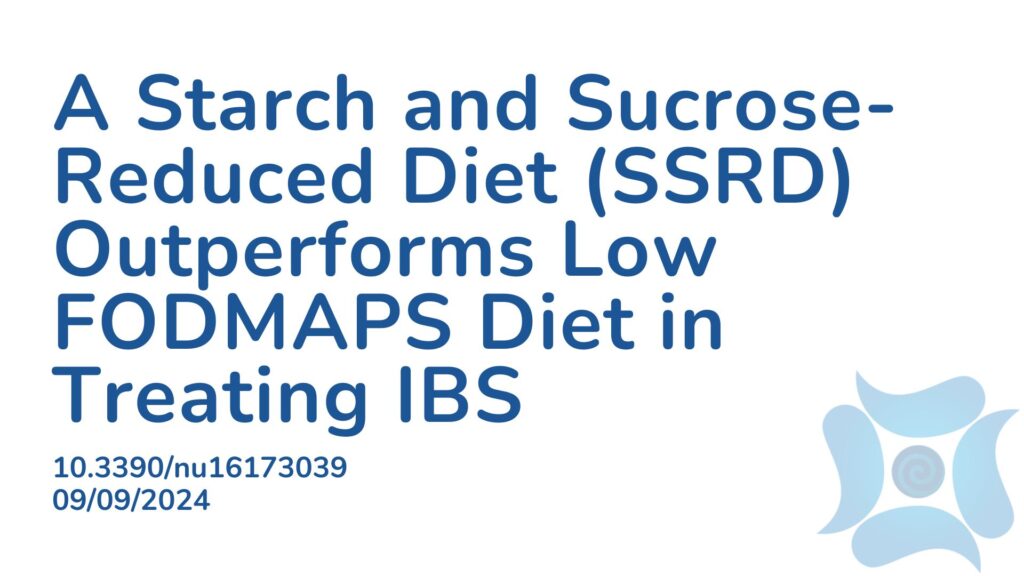Summary:
Irritable bowel syndrome (IBS) is the most prevalent disorder of gut-brain interaction (DGBI). Functional gastrointestinal (GI) symptoms are reported in about 40% of the general population, with many patients experiencing exacerbated symptoms after eating. The primary treatment for IBS is dietary modification, specifically a low fermentable oligo-, di-, and monosaccharides and polyols (FODMAP) diet. A low FODMAP diet reduces lactose, fructose, fructans, galacto-oligosaccharides, and polyols, which are fermentable carbohydrates that increase the water content in the small intestine and cause gas production in the colon, leading to bloating, pain, and altered bowel habits. However, many patients find the low FODMAP diet complex and highly restrictive. Long-term reduction of various food items may also risk malnutrition. Alarmingly, 25-50% of IBS patients continue to experience symptoms even while adhering to a low FODMAP diet. The high consumption of sugar and processed foods in Western diets may also increase the likelihood of developing IBS symptoms, partly due to genetic variants related to enzyme deficiencies in breaking down starches. Given these recent findings, the efficacy of a starch- and sucrose-reduced diet (SSRD) has been explored in IBS, showing marked symptom improvement. The SSRD emphasizes the reduction of sucrose, starch, and added sugars. While there is some overlap with the low FODMAP diet, the key distinction is that SSRD permits the consumption of fructans, fructose, lactose, and certain sweeteners. The primary aim of this study was to evaluate SSRD against the established low FODMAP diet after a 4-week dietary intervention for both diets. Secondary objectives include assessing symptoms at 6 months and examining effects on other intestinal symptoms, sugar cravings, and blood pressure. A total of 155 IBS patients were randomized to receive either SSRD or low FODMAP for 4 weeks, followed by a 5-month follow-up without dietary restrictions. Measurements of weight, height, waist circumference, and blood pressure were also taken. No significant differences were observed between the groups at baseline. SSRD resulted in more significant reductions in weight, body mass index (BMI), and sugar cravings. In the SSRD group, responders at 6 months maintained lower weight and BMI compared to baseline. Among those who tried both diets, a preference for SSRD was noted. In conclusion, a 4-week SSRD intervention was found to be more beneficial when compared with the low FODMAP diet regarding gastrointestinal IBS symptoms. Additionally, both diets resulted in significant reductions in other gastrointestinal symptoms, with SSRD showing more pronounced decreases in weight, BMI, and sugar cravings.
Abstract:
A diet with low content of fermentable oligo-, di-, and monosaccharides and polyols (FODMAP) is established treatment for irritable bowel syndrome (IBS), with well-documented efficiency. A starch- and sucrose-reduced diet (SSRD) has shown similar promising effects. The primary aim of this randomized, non-inferiority study was to test SSRD against low FODMAP and compare the responder rates (RR = ∆Total IBS-SSS ≥ −50) to a 4-week dietary intervention of either diet. Secondary aims were to estimate responders of ≥100 score and 50% reduction; effects on extraintestinal symptoms; saturation; sugar craving; anthropometric parameters; and blood pressure. 155 IBS patients were randomized to SSRD (n = 77) or low FODMAP (n = 78) for 4 weeks, with a follow-up 5 months later without food restrictions. The questionnaires Rome IV, IBS-severity scoring system (IBS-SSS), and visual analog scale for IBS (VAS-IBS) were completed at baseline and after 2 and 4 weeks and 6 months. Weight, height, waist circumference, and blood pressures were measured. Comparisons were made within the groups and between changes in the two groups. There were no differences between groups at baseline. The responder rate of SSRD was non-inferior compared with low FODMAPs at week 2 (79.2% vs. 73.1%; p = 0.661;95% confidence interval (CI) = −20–7.2) and week 4 (79.2% vs. 78.2%; p = 1.000;95%CI = −14–12). Responder rate was still high when defined stricter. All gastrointestinal and extraintestinal symptoms were equally improved (p < 0.001 in most variables). SSRD rendered greater reductions in weight (p = 0.006), body mass index (BMI) (p = 0.005), and sugar craving (p = 0.05), whereas waist circumference and blood pressure were equally decreased. Weight and BMI were regained at follow-up. In the SSRD group, responders at 6 months still had lowered weight (−0.7 (−2.5–0.1) vs. 0.2 (−0.7–2.2) kg; p = 0.005) and BMI (−0.25 (−0.85–0.03) vs. 0.07 (−0.35–0.77) kg/m2; p = 0.009) compared with baseline in contrast to non-responders. Those who had tested both diets preferred SSRD (p = 0.032). In conclusion, a 4-week SSRD intervention was non-inferior to low FODMAP regarding responder rates of gastrointestinal IBS symptoms. Furthermore, strong reductions of extraintestinal symptoms were found in both groups, whereas reductions in weight, BMI, and sugar craving were most pronounced following SSRD.
Article Publication Date: 09/09/2024
DOI: 10.3390/nu16173039



